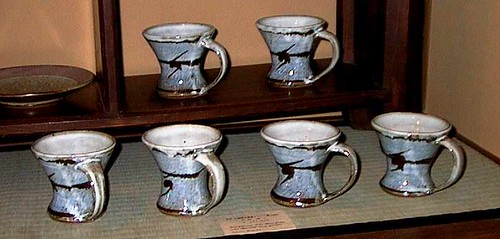 “We can make our minds so like still water that beings gather about us that they may see, it may be, their own images, and so live for a moment with a clearer, perhaps even with a fiercer life because of our quiet.” --W.B. Yeats
“We can make our minds so like still water that beings gather about us that they may see, it may be, their own images, and so live for a moment with a clearer, perhaps even with a fiercer life because of our quiet.” --W.B. Yeats
I came to pottery from my studies in Zen and a life long interest in ecology, anthropology and archeology. I make functional pottery in an effort to preserve local culture in our modern hyper-active, information intense society. If we take a stand where we live, and attempt to understand that place, we can create something that preserves and maintains the nature of that place. My main goal is to inspire other people to make their own creative work.
Human beings have always worked with their hands. We are creators. We cannot survive by consuming only. We need both creativity and Nature to be healthy and whole human beings. Making and using handmade pottery is one way to bring Nature and culture together in our lives.
I intend my work to affect people who use it the way the green countryside affects someone who normally lives in the city: The fresh air & the green of the trees and grasses restores the soul & refreshes the spirit. If my work can do this, in a small way, it is successful.
I came to my personal understanding of Mingei and The Arts and Crafts Movement from working with my late teacher Tatsuzo Shimaoka and from observing the family farmers who were my neighbors in Mashiko, who lived according to the natural seasonal cycles. Distilled, it comes down to four basic principles:
1.Humans are naturally creative.
We are informed by Nature about creativity and beauty.
2.Objects should be judged by how they fulfill the human need for creativity.
Our tools are enablers.
3.We best function when we know the people whose products
we depend upon and the people who likewise depend upon us.
4.When human creative needs are met,
it is also beneficial to the ecology of the environment.
In addition, as a maker, it is important to use materials of the place where you work and live or materials that are relevant to them. It is also important to listen to the materials and be informed by their strengths and weaknesses. Being true to the materials, rather than trying to hide what they are.
The Shaker craftsmen gave us these principles:
Industry:
"Do all your work as if you had a thousand years to live
and as if you were to die tomorrow."
Honesty:
"Be what we seem to be; and seem to be what we really are;
don't carry two faces."
Functionalism:
"That which in itself has the highest use possesses the greatest beauty."
Kiln Prayer: Clay, Water, Fire
 As we become a post-industrial society, people who work with their hands are finding themselves being displaced by automation. In all advanced civilizations, artists and artisans and their work has been supported by society. If our culture chooses to do so, displaced farmers, autoworkers, and other factory workers can become artisans and artists. This was a realization of William Morris and Soetsu Yanagi and influenced their humanistic approach to making things. Philosophers Hannah Arendt and Max Scheler called man Homo Faber, “Man the Maker.” It is all about switching our mindset from one of being “consumers” to one of being Makers. We are all makers at heart.
As we become a post-industrial society, people who work with their hands are finding themselves being displaced by automation. In all advanced civilizations, artists and artisans and their work has been supported by society. If our culture chooses to do so, displaced farmers, autoworkers, and other factory workers can become artisans and artists. This was a realization of William Morris and Soetsu Yanagi and influenced their humanistic approach to making things. Philosophers Hannah Arendt and Max Scheler called man Homo Faber, “Man the Maker.” It is all about switching our mindset from one of being “consumers” to one of being Makers. We are all makers at heart.



























